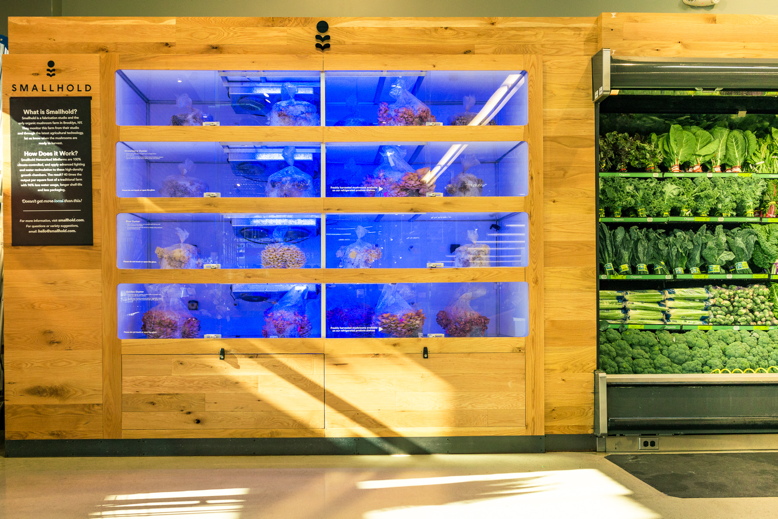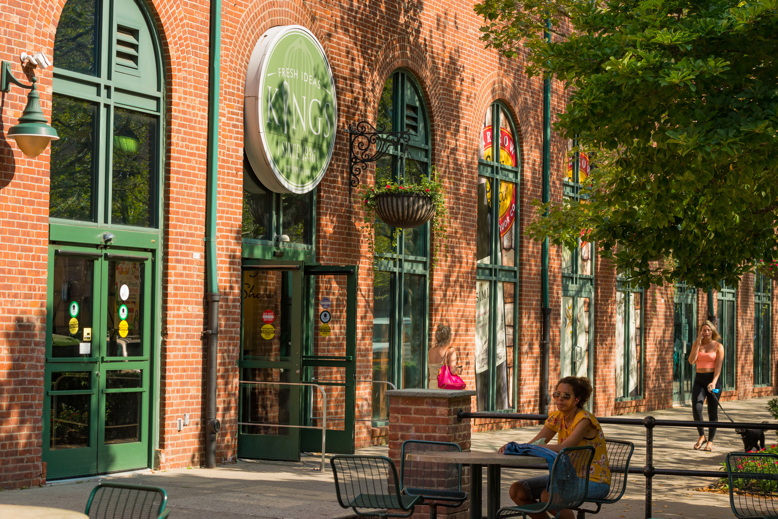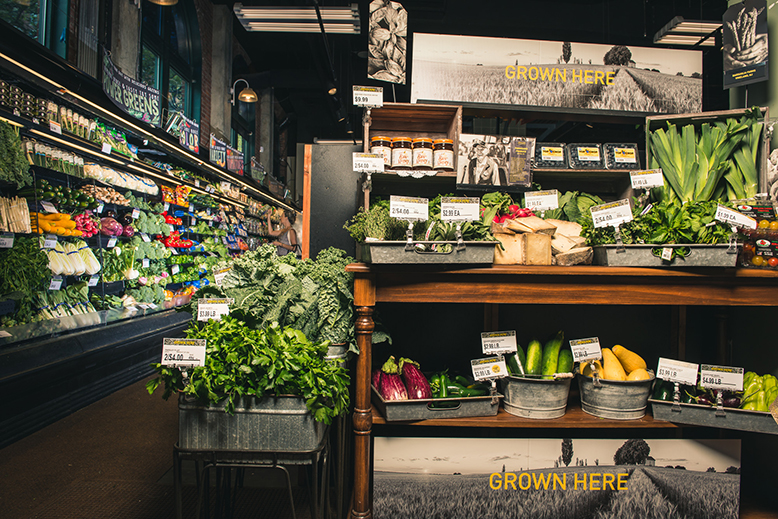
Over the past several years, you may have witnessed an uptick in the number of cartons waiting on your neighbors’ doorsteps—or even on your own—stamped with logos from brands like Boxed and Blue Apron. The boxes represent a revolution in the way we buy groceries—and present an unprecedented challenge to the traditional supermarket business.
These days, you don’t have to leave the house to feed yourself and your family—and you can feed them well. Shopping for groceries online or on your phone is an attractive proposition, especially for the digital-oriented consumers who have taken a wrecking ball to physical retailing, from bookstores to boutiques.
But supermarkets are fighting back. Familiar names like Kings, Wegmans and Whole Foods are developing new ways to stay relevant, enhancing their in-store selections of local products and private-brand offerings, creating unique, hands-on shopping experiences, and improving their online ordering systems to keep up with the changing consumer.
Armed with these and other initiatives, some grocery executives even sound optimistic in the face of the broader retail apocalypse. “Online is never going to satisfy,” says Stephen Corradini, chief merchandising and marketing officer for Kings Food Markets. “If you want to pick up an apple, tomato, or a steak, that’s tough to do online. There’s a natural advantage to brick-and-mortar retail.”

Clockwise from top left: Customers pick out heirloom Jersey tomatoes at Kings; on-the-go, precut organic fruit at Whole Foods; ripe watermelons at Sprouts Farmers Market; taking a scoop of dried fruit in the bulk-bin aisle at Whole Foods. Photos by Peter Murphy
Competition is fierce
The supermarket business has always been tough, with profit margins often below 3 percent. Then came the February 2005 launch of Amazon Prime, a shopping service offering free two-day shipping to members. In the ensuing years, smartphones became ubiquitous; grocery delivery apps like Instacart, FreshDirect and Peapod seamlessly eliminated the physical aspect of shopping; and meal-kit companies like Blue Apron and HelloFresh set out to convince time-crunched consumers there’s an easy way to prepare healthy meals.
Add the competition for grocery sales from big-box discounters like Target, Walmart and Costco, and you’ve got a supermarket sector with a seemingly unconquerable mountain to climb.
Some grocers have been hit hard. Pathmark, founded in Woodbridge in 1968, closed all of its locations after its parent company, A&P, ceased operations in 2015. The closings seemed to be a portent of bad things to come.
RELATED: Can New Jersey’s Dying Malls Be Saved?
“In New Jersey, the competition for food dollars is fierce,” says Linda Doherty, president and CEO of the NJ Food Council. “It’s a dynamic marketplace with heavy competition.” Doherty confirms that online shopping and millennials’ changing shopping habits are some of the biggest challenges facing grocery stores today. In addition, New Jersey’s low unemployment rate (which makes recruitment difficult) and minimum-wage increases (which raise costs) affect the way grocers do business. “These ingredients are the recipe for a food industry that’s under pressure,” she says. Another ingredient: the price of real estate and other operating costs in New Jersey, which are above the national average.
Consumers don’t care about any of that. They simply expect quality items at a good price and a shopping experience that’s quick and convenient. Why pay more for laundry detergent or pet food if you can find it online for less? Why lug home heavy items when they can be delivered to your doorstep? Why search the aisles for niche items like international specialty foods when they are a few clicks away online?
Loyalty is waning, too. According to a recent Food Marketing Institute report, the average American consumer visits more than four places a month to meet their grocery needs, likely the result of bargain hunting. Only 1 in 10 consumers can name a primary store where they do their shopping.

The sleek exterior of Lidl in Eatontown. Photo by Peter Murphy
Further complicating the market in New Jersey is the arrival of discount supermarkets Lidl and Aldi, both German chains. Lidl opened its first New Jersey location in Vineland in late 2017, and has added three other locations in Union, Hazlet and Eatontown. The stores offer a bare-bones shopping experience with bargain prices, like 25 cents for a box of macaroni and cheese. Aldi entered the Jersey market in 1996 and now has more than 40 stores here.
But supermarket operators are a resilient bunch. Despite the sudden closing of Pathmark and A&P stores in 2015, some chains see opportunity. Over the past two years, Wegmans has added two new stores, in Hanover and Montvale, their first forays into North Jersey. Trader Joe’s has 13 New Jersey locations and three more on the way. Sprouts Farmers Market, a health-conscious grocery chain headquartered in Phoenix, opened its first store here in Marlton in June. This fall, New England chain Stew Leonard’s will open its first New Jersey grocery at the Paramus Mall, joining the several liquor stores it already operates in Bergen, Passaic and Union counties.
What consumers want
Today, nearly every town in New Jersey has a weekly farmers market, a sure sign of changing consumer tastes. A decade ago, the average consumer didn’t know what quinoa was (or how to pronounce it) and hadn’t yet discovered kale or kombucha. Now, these are popular items in many households—and essentials for supermarkets in step with the times. Similarly, consumers are demanding a wider selection of quality, non-GMO, local, organic, natural and plant-based products.
“The food retailing experience is moving at its fastest pace ever,” says the NJ Food Council’s Doherty.
Some stores are adapting better than others. Kings Food Markets, a regional company with 23 locations in North and Central Jersey, uses signs that read “local” (known in the trade as shelf talkers) to point out products from New Jersey and neighboring states. These appear everywhere from the pasta-sauce aisle to the meat and seafood sections. In the produce section, photos of real farmers hang next to the eggplants, lettuces, tomatoes and herbs they grew.
“What we’re trying to do here is to bring folks on a journey of discovery with us,” says Kings’s Corradini. “We want to make sure that part of the experience is that you learn who the folks making, growing, producing, roasting and cooking your food are.”
In May, Kings hosted Meet the Makers events in its stores. Local producers—including Brad Finkel of Hoboken Farms, Diana Levy of Undercover Quinoa, and the family who runs Somerset County’s Griggstown Farm—provided samples of their food. The events helped draw a connection that many customers find increasingly appealing.
“They’re meeting the people whose blood, sweat and tears went into producing this product, whose dream it was to make this,” says Corradini. “There’s very real, tangible benefits for that.”
Other supermarkets, such as Wegmans (which declined to comment for this story) and Whole Foods also have begun carrying and marketing more locally sourced offerings in recent years. News that Whole Foods had been purchased by Amazon shook the industry two years ago. But despite the worries surrounding the acquisition, Whole Foods has kept its identity as a grocer with high standards (prohibiting products with high-fructose corn syrup; carrying only wild-caught or responsibly farmed seafood; strictly supplying meat without antibiotics or added hormones), while simultaneously offering lower prices and discounts for Amazon Prime members.

Organic mushrooms grow in a vertical farm unit at the Bridgewater Whole Foods. Photo by Peter Murphy
To meet the growing demand for locally sourced ingredients, Whole Foods employs regional “foragers” to search for new locally made food and provisions. “Our approach is to be as hyper-local as possible within each region,” says Chris Manca, a forager for the 20 Whole Foods stores in New Jersey. “Whenever we can source locally, we do. Produce is an obvious example of that, and also meat. But if we happen to find a great example of a kombucha, tea, or coffee, then we’ll focus on those brands instead of brands that are local to another region.”
The interest in local products is good news for small businesses. Whole Foods often incubates local businesses to help them grow to a national scale, such as the Westmont-based Severino Pasta Company, which Manca calls “a real local success story.” Severino started supplying fresh and dried pasta for a few Whole Food stores, then all the stores in the tristate area, and eventually grew large enough to supply nationally. Additionally, Severino supplies the dry pasta under Whole Foods’ 365 label. Now, Whole Foods stores from New England to Florida have a Severino Pasta Bar, where customers can buy a variety of fresh pasta, like cheese-stuffed rigatoni, pumpkin gnocchi, orecchiette and nested fettuccine, by the pound.
Severino employees frequently visit Whole Foods stores to give pasta-making demonstrations, a concept that fulfills consumer desire for more hands-on experiences. Consumers also seek out cooking demonstrations and free samples. They want access to a variety of time-saving, on-the-go meals, too. To keep up with those needs, some places are rolling out meal kits to compete with Blue Apron and HelloFresh, including Kings, which launched a Provisions meal-kits line in July.

“Groceraunt” JBQ Restaurant at the Millburn-Union Whole Foods. Photo by Peter Murphy
The shopping experience can also include eating. Modern food halls, where local restaurants run fast-casual stands, are growing in popularity among millennials, and smart supermarkets are following the trend. “Food-hall culture has really changed the way people eat,” says Manca. In three New Jersey stores, Whole Foods partners with outside businesses, like Curiosity Donuts in their Princeton store and the Juice Press in the Bridgewater location to add to the shopping experience. Also in the Bridgewater Whole Foods is an in-store miniature mushroom farm. The Millburn-Union Whole Foods has an in-store Jamaican barbecue place called JBQ Restaurant. This so-called “groceraunt” concept is gaining traction across the country. “That’s definitely something that is going to be a bigger part of our future,” says Manca. (In some states, supermarkets have installed in-store, craft-beer bars with great success, but New Jersey’s alcoholic beverage licensing doesn’t allow this innovation.)
Some supermarkets, like Trader Joe’s and Aldi, set themselves apart by predominantly offering products under their own brand. Anyone who shops at one of New Jersey’s Trader Joe’s stores can name favorite items, such as the popular Speculoos Cookie Butter and frozen Indian meals line, which they can’t find anywhere else. At Aldi, 90 percent of the products on shelves are exclusive brands that are priced lower than big-name brands in other stores.
Shop-from-home programs are another way traditional grocers can make shopping more convenient and efficient. ShopRite From Home, ShopRite’s online shopping service, has operated since 2002, but shoppers can now place their pick-up or delivery orders through the supermarket’s app. Others, such as Aldi, Kings and Wegmans, partner with Instacart to offer grocery delivery to customers. Wegmans also has a curbside pickup option. Kings is investing more in this area as well. And since Amazon now owns Whole Foods, their employees do the shopping for same-day Prime grocery deliveries.

An employee fills an online Amazon order at Whole Foods, an increasingly popular grocery-shopping method. Photo by Peter Murphy
The future of grocery shopping
For grocery stores, what’s old is new again. Thanks to the renewed focus on fresh goods, patrons are likely to make more trips to the store. The middle aisles, filled with nonperishable goods easily shipped to homes, have been reduced in importance.
“The fresh departments, around the perimeter of the store, is really where we’re seeing the growth as customers look for more fresh products to include in their diet,” says Karen Meleta, ShopRite’s vice president of consumer and corporate communications. She emphasizes the importance of carrying a larger assortment of organic produce.
It’s a model that Sprouts, which eschews traditional aisles in favor of stores designed more like farmers’ markets, understands well. Think open space, beautiful produce, and barrels of bulk goods like oats, grains and nuts. That means less plastic packaging—another factor that’s important to a growing number of consumers.
The bottom line: In order to survive, supermarkets must do more than stock the essentials. Grocery shoppers, especially younger ones, must be given a premium shopping experience that they can’t find online.
Even a millennial like Hillsborough resident Daniel Bivas still likes to pick his own tomatoes. “You can never replicate the experience of picking fresh produce, meats and cheeses at the grocery store,” he says. “It involves senses that can only be felt in that environment.”







